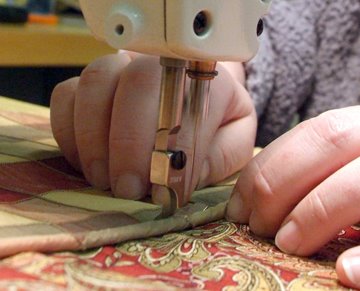Walls can be an intimidating prospect... all that space to do whatever you want! Unlike the rest of the room, where function and necessity provide a loose guideline (table, check, two chairs, check, sofa, check), the walls are completely up to your own discretion.
The art work and photographs that you choose to display on your walls are a completely personal expression. There is no right or wrong way to choose what you put on your blank canvas. However, whether you choose flea market prints, photographs of loved ones, or pieces by famous artists, there are some basic rules that will allow you to display these works in the most aesthetically pleasing way possible.
Let's take a look at some of the do's and don't of wall decor.
- Do not make the mistake of assuming that the right height to hang a piece is at eye level. People vary so much in height, from a 4'11" woman to a 6'11" man, that you will never find a generic "eye level" that works.
- Do hang your art work in relation to the furniture in the room. Aim for 6"-10" above the closest furniture (a sofa, table, etc.) This is close enough to create a cohesive look between the furniture and the art work without looking cramped. Any further and your arrangement may start to look disconnected from the foundation of the room.
- Do consider proportions between your wall decor and your furniture. At the least, a work should be one half the width of the furniture beneath it. If you absolutely love a piece that is smaller than this, you can flank it with smaller works, but never float a tiny painting above a large sofa!
- Do not go into the hanging process unprepared. Work out arrangements on the floor, then transfer paper cutouts of the work to the wall with painter's tape before ever thinking about taking a nail to your wall. No one wants to spend an afternoon with a wall full of nail holes and a jar of putty, so do not make decisions impulsively.
For design inspiration:
Traditional furniture shapes and beachy colors take on a funky edge when juxtaposed with the owner's modern art collection. Don't be afraid to mix styles.
Groupings look best when the subject matter and tone of the paintings is similar. Use complementing frames and do not hang further than 3"-4" apart to maintain the feel of a true grouping.
The matching white frame, white matte look of these photos creates an organic sense as it grows from the table onto the wall.
Pairs are a powerful look. These two bold paintings draw in the green from the fabric in the room and pop against the neutral wall covering.
Small paintings and photographs hung in a bookcase are a charming touch if you have extra space to fill.
This photograph is truly a work of art when color enhanced and split on to four separate canvases. For a child's room, or any fun room, this is a spirited and playful way to showcase your favorite family photos.
Black and white can be so powerful. When hung against deep red walls, these black and white photographs are stunning. The blown up photograph makes a huge impact, especially when set to the right of the sofa instead of directly above, where one might expect it.
Darling for a young girl's room or a powder room, photographs hung upon ribbons are an ultra-feminine, yet sophisticated, look.
This room is so rich in different textures and varying neutrals, that one large-scale modern painting is all that is necessary to adorn the walls perfectly. Anything else would be overkill.
Pictures say a million words. When displayed in large groupings as seen above, one can spend hours getting lost in the images. This type of display would be perfect for a guest room or hallway.
Lastly, a tip from Martha Stewart Living on how to hang pictures accurately without ever making an unnecessary nail hole:
- Use large craft paper to trace the outline of your frame and cut out.
- Pull the hanging wire on the frame into a taut arc. Measure the distance to the top of the frame.
- Mark this spot on the template then lay the picture hook over the template and mark where this will go.
- Using painter's tape or some other non-residue tape, hang the template where you will want the frame to go.
- Hammer the nail through the mark on the template.
- Remove the template and you have a perfectly placed nail.
Use these basic do's, don'ts, and tips along with your sense of how to best display your art work and photographs and your walls go from blank and bare to wonderful.
Photos: Phoebe Howard, House Beautiful, Real Simple, Martha Stewart Living, Elle Decor, Coastal Living










































